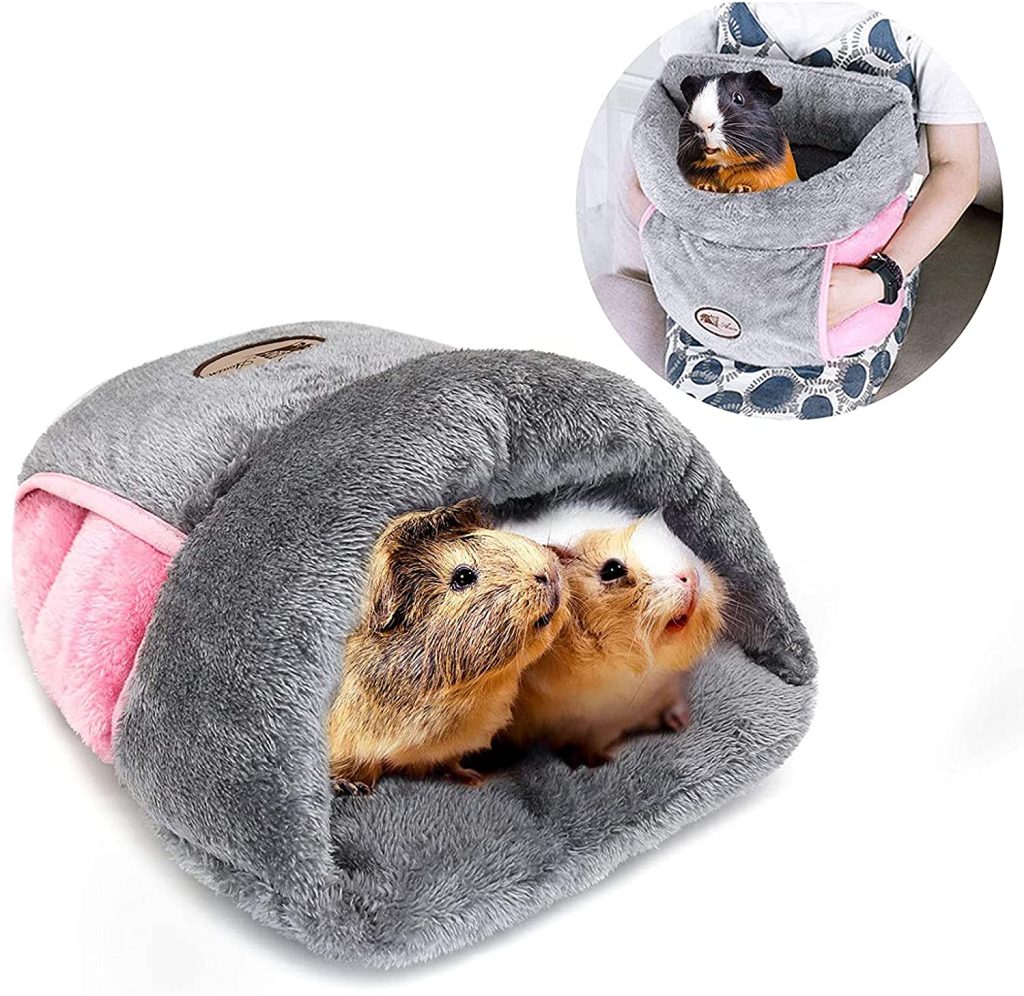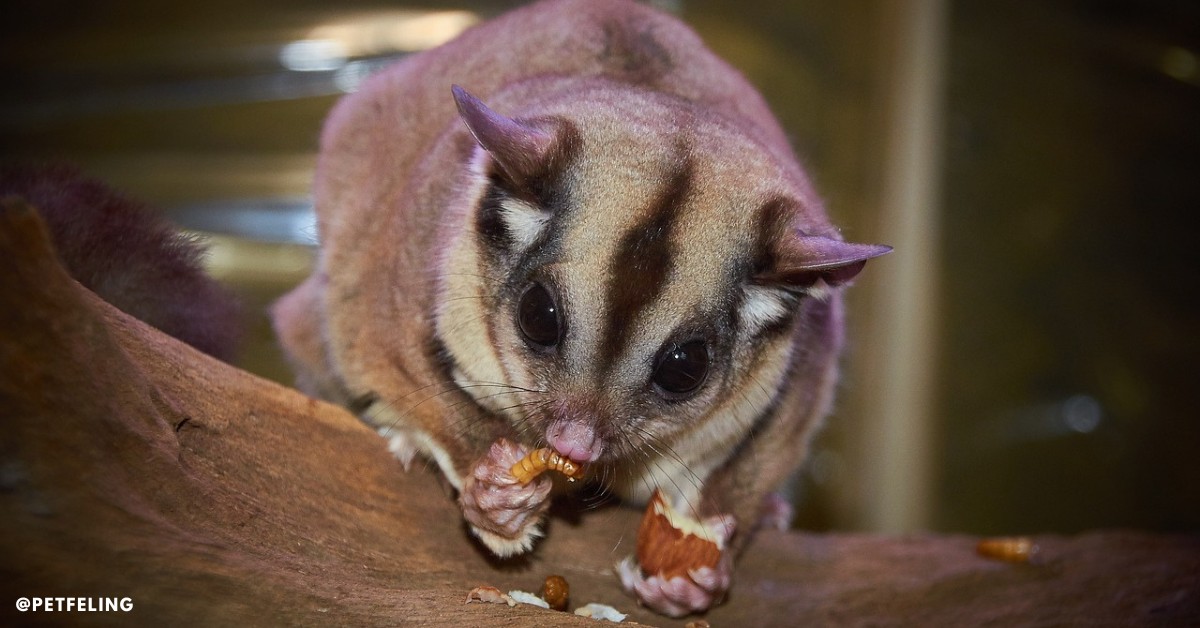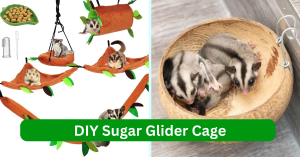Small, arboreal marsupials known as sugar gliders are indigenous to the forests of Australia, Indonesia, and Papua New Guinea. They get their name from the fact that they can glide thanks to a thin skin membrane called a patagium that extends between their front and back legs. Due to their fun and friendly nature, sugar gliders are frequently kept as pets. They go by the names “sugar bears” or “honey gliders” because of their natural diet, which consists of nectar, pollen, and sap.
Enclosure
When setting up a space for sugar gliders, keep the following in mind:
- Size: Sugar gliders require a large amount of space to play and exercise. A minimum cage size for one or two sugar gliders is roughly 6 feet long, 4 feet wide, and 6 feet tall. Even larger enclosures are required for larger gatherings.
- Material: The enclosure should be composed of a strong, chew-proof material, like tough plastic or metal. It is not advised to use wire mesh because it can be too harsh on their tender feet and toes.
Substrate: To give the sugar gliders a cozy and secure place to rest and play, the cage should have a substrate like shredded paper, coconut coir, or aspen shavings. Cedar shavings should not be used since they may injure small animals. - Enrichment: Sugar gliders are intelligent, observant creatures that require a lot of mental and physical stimulation to remain content and healthy. To keep them occupied, surround them with a variety of toys, including climbing frames, swings, and foraging toys.
- Temperature: Because they are tropical natives, sugar gliders require a warm, humid environment to survive. Keep the temperature in the enclosure between 70 and 80 degrees Fahrenheit and give the animals a heat source, like a ceramic heater, at night to keep them warm.
- Diet: Sugar gliders need to eat a variety of foods, including fresh fruits and vegetables, high-quality pellets made specifically for sugar gliders, and occasionally insects or hard-boiled eggs as treats. Always have clean water available. You can help guarantee that your sugar gliders have happy, healthy lives by giving them a large, secure enclosure and attending to their dietary and behavioral demands.
Bedding
It’s crucial to pick bedding materials for sugar gliders that are secure, cozy, and simple to maintain. Some excellent bedding choices are:
- Aspen shavings: Due to their safety, comfort, and ease of cleaning, aspen shavings are a popular option for sugar glider bedding.
- CareFresh: Made from recycled paper fibers, CareFresh is a brand of bedding. It is both soft and cozy, as well as biodegradable.
- Fleece: Another favorite material for sugar glider bedding is fleece. It is plush, cozy, and simple to clean.
- Shavings of pine or cedar should be avoided since they could be detrimental to the respiratory systems of sugar gliders.
To make sure that your sugar gliders have a clean and cozy living space, it is crucial to routinely clean and replace the bedding.

Order this adorable bed for your Sugar glider from Amazon for just $18.99
Sleeping
Being nocturnal means that sugar gliders are awake at night and asleep during the day. They normally sleep for roughly 8 to 12 hours every day.
Due to their gregarious nature, sugar gliders should be kept in pairs or small groups. They occasionally sleep in a nest constructed of leaves and twigs and are known to cuddle up to one another while they are dozing. Making sure your sugar gliders have a cozy and safe place to sleep is crucial. This could be a tiny cage or enclosure with fleece or aspen shavings as the bedding. You can also give them a nest box or another area to hide so they can slumber soundly. To ensure that your sugar gliders can get the rest they require, keep the sleeping space calm and uncluttered.
Feeding
Sugar gliders are omnivorous creatures, which means that both plants and animals are part of their diet. They consume a range of items in the wild, including fruits, insects, nectar, and sap as mentioned earlier.
A balanced diet for a pet sugar glider should contain the following:
- A premium commercial diet for sugar gliders A diet with a variety of nutrients and one that is especially designed for sugar gliders should be sought out.
- Fruits and vegetables: As a dietary supplement, give them a range of fresh fruits and vegetables. Apples, pears, melons, grapes, carrots, and leafy greens are all healthy choices.
- Insects: Mealworms and crickets are two insects that can provide the protein that sugar gliders require in their diet.
- Nectar: You can give your sugar gliders a small amount of nectar as a treat. You can make this by combining water with a tiny bit of sugar or honey.
To make sure that your sugar gliders are receiving all the nutrients they require, it is crucial to provide a variety of foods. Foods heavy in sugar or fat should be avoided because they can cause health issues.
Socialization
Due to their gregarious nature, sugar gliders should be kept in pairs or small groups. They can develop close relationships and be highly affectionate with their caregivers. To guarantee that your sugar gliders are at ease with people and other animals, it is crucial to socialize them appropriately. You can help your sugar gliders grow up to be sociable and well-adjusted pets by using the advice in this article.
Here are some pointers for socializing with your sugar gliders:
- Get them accustomed to handling first: To get your sugar gliders accustomed to being handled, do so gently and with treats.
- Introduce new people to your sugar gliders gradually by letting them observe and engage with them from a distance before allowing them to be touched.
- Introduce them to a range of environments: Take your sugar gliders on excursions to various settings to help them become used to new sights and sounds.
- Give your sugar gliders lots of social interaction by playing with them or giving them goodies throughout the day.
Bathing
Unlike some other pets, sugar gliders do not require frequent bathing. In fact, frequent bathing might dry up their skin by removing its natural oils. But occasionally, it can be necessary to bathe your sugar glider.
Here is some advice if you must bathe your sugar glider:
- Make sure the water is not excessively hot or cold when using lukewarm water.
- Use a light shampoo that is safe for pets. Look for shampoo that is made especially for small animals.
- Sugar gliders are susceptible to ear infections, so take care not to get water in their ears.
- Massage the shampoo gently into their fur, taking your time to ensure that it is completely washed out.
- Dry them completely. To dry the fur on your sugar glider, use a fresh, soft towel. To assist them in drying off, you can also use a hair dryer on a low setting. Just be careful not to get the heat too close to their skin.
Giving your sugar glider a wash should only be done when absolutely necessary, and even then, you should be cautious and careful.
Caging
A crucial component of keeping sugar gliders as pets is cages. Your sugar gliders’ health and well-being depend on having an appropriate cage. When choosing a cage for your sugar gliders, take into account the following factors:
- Size: Sugar gliders require a lot of space to move about because they are an active species. For a pair of sugar gliders, a cage with a minimum dimension of 24 inches by 24 inches by 36 inches is advised.
- Bar spacing: To prevent your sugar gliders from fleeing, the cage’s bars should be placed closely together. It is advised to use a 1/2-inch minimum distance between objects.
- Material: The cage should be constructed of a durable material like metal or premium plastic.
- Security: To keep your sugar gliders safe, the cage should be impenetrable and secure.
- Ventilation: To provide your sugar gliders access to fresh air, the cage needs to be well ventilated.
- Cleaning convenience: To maintain a healthy environment for your sugar gliders, it’s crucial to be able to quickly clean their cage.
To keep your sugar gliders active and interested, it’s crucial to supply them with an appropriate cage as well as a lot of toys, climbing branches, and other stimulating objects.
Stress
Numerous animals, including sugar gliders, frequently struggle with stress. Numerous things, including environmental changes, a lack of social engagement, and health issues, can contribute to stress. Changes in behavior, such as increased aggression or sluggishness, changes in eating habits, and adjustments in grooming habits are all potential indicators of stress in sugar gliders. To avoid more severe health issues, it’s critical to spot and treat stress in your sugar gliders as soon as it appears. If you want to reduce stress in your sugar gliders, you must provide them with a secure, predictable environment and spend time interacting with them every day. It’s also crucial to take care of any medical conditions that might be stressing you out. It is crucial to consult a veterinarian or other expert in animal behavior for assistance on how to handle the situation if you believe your sugar glider is under stress. Your sugar gliders’ general health and happiness depend on how well you handle and care for their emotional needs.
Other common Medical Disorders
Small marsupial creatures called sugar gliders are frequently kept as pets. Like all animals, sugar gliders are susceptible to a wide range of illnesses. The following are some frequent medical conditions that sugar gliders may experience:
- Diabetes mellitus: The sugar glider’s body is unable to control blood sugar levels in this condition. Sugar gliders can exhibit symptoms such as lethargy, weight loss, increased thirst and urination, and diabetes.
- Diarrhea, constipation, and pancreatitis are just a few of the gastrointestinal ailments that sugar gliders may encounter.
- Illnesses of the respiratory system: Due to inadequate husbandry practices or exposure to respiratory irritants, sugar gliders may develop respiratory infections such as pneumonia.
- Skin issues: Sugar gliders are susceptible to skin issues, including mites or other parasites, infections, or allergies.
- Cancer: Sugar gliders, like all animals, are susceptible to developing cancer, which can be challenging to cure and may call for surgery or other invasive procedures.
- To detect and address any medical issues as soon as possible, it’s critical to get your sugar glider inspected by a veterinarian on a regular basis.
- Dental Disease Sugar gliders, like many tiny mammals, are prone to dental issues, especially overgrown or misplaced teeth. Genetics, food, and insufficient chewing opportunities are only a few of the causes of this. A sugar glider’s inability to eat, weight loss, or facial or mouth puffiness could be symptoms of dental issues. Dental abnormalities might cause more serious health problems if not treated. Give your sugar gliders a balanced diet that includes a range of fresh fruits and vegetables, as well as chewable like branches and toys, to help prevent dental issues in the future. To find and treat any tooth issues as soon as possible, routine veterinary exams are also essential. It’s critical to get veterinarian care as soon as you can if your sugar glider has dental issues. To resolve the situation, the veterinarian may suggest a course of action such tooth extraction or trimming. The general health of your sugar gliders depends on the proper management and treatment of their oral health.
Do Sugar Gliders Make Good Pets?
Some people may find sugar gliders to be good pets, but not everyone may find them to be the best option. If you’re considering getting a sugar glider as a pet, take these points into account:
Sugar gliders are nocturnal, which means that nighttime is when they are most active. For some people, this can make it challenging to develop a relationship with their pet or to care for them throughout the day. A particular diet that contains a range of fruits and vegetables, sources of protein, as well as a calcium supplement, is necessary for sugar gliders. They also require constant access to fresh water. Because they are sociable creatures, sugar gliders thrive in pairs or small groups. In order to keep from feeling lonely or agitated, a single sugar glider will require a lot of interaction from its owner. Before acquiring a sugar glider as a pet, it is vital to check local legislation, as certain jurisdictions and nations do not allow its ownership. Diabetes and digestive problems are two conditions that sugar gliders are susceptible to and may need ongoing care for.
Where Can I Get a Sugar Glider?
You might be able to adopt a sugar glider from one of the following places:
- Breeders: Sugar glider breeders who specialize in this breed may have infants or young adults up for adoption. It’s crucial to do your research and pick a respected breeder who uses ethical breeding methods and gives their animals the attention they require.
- Shelters and rescues: Sugar gliders might be up for adoption at some animal shelters and rescue groups. These animals may have been saved from abuse or neglect or given up by their previous owners.
- Online classified sites, such as Craigslist or Facebook Marketplace: You might be able to find sugar gliders for sale or adoption on these sites. However, it’s crucial to exercise caution when making an online animal purchase and to fully investigate the seller before making any commitments.
- Before introducing a sugar glider into your home, it’s crucial to give the decision serious thought. Before making the decision to adopt a sugar glider, it is crucial to be sure you are ready to meet their demands. Sugar gliders require specialized care and attention.
How Much Does It Cost To Own a Sugar Glider?
The price of keeping a sugar glider can vary based on a variety of elements, such as the animal’s age and health, the price of food and supplies, and any potential medical costs. When creating a budget for a sugar glider, take into account the following possible expenses:
- Price: Depending on the age and quality of the animal, the price to buy a sugar glider from a breeder or pet shop can range from $100 to $400 or more.
- Housing: A cage that is at least two feet long, two feet wide, and four feet tall is required for sugar gliders. A good cage might cost anywhere from $100 to $300 or more.
- Food, supplies, and care: Sugar gliders need a particular diet that consists of a range of fruits and vegetables, sources of protein, and a calcium supplement. Depending on the price of the ingredients and the size of the animal, this can cost $50 to $100 every month. Additionally, sugar gliders require constant access to fresh water.
- Medical costs: Sugar gliders may need routine veterinarian examinations and may have conditions that call for treatment. Veterinary care can be very expensive, so it’s crucial to set aside money for anticipated medical costs.
Depending on the animal’s particular demands and the expenses you have, owning a sugar glider might cost anything from a few hundred dollars to over a thousand dollars annually. Before deciding to welcome a sugar glider into your home, it is crucial to thoroughly weigh the prospective costs of ownership.
Conclusion
A particular diet that contains a variety of fresh fruits and vegetables, protein sources, as well as a calcium supplement, is necessary for sugar gliders. Always having access to fresh, clean water is crucial. A cage that is at least two feet long, two feet wide, and four feet tall is required for sugar gliders. The cage needs to be kept in a calm, moderate environment that is free from drafts and temperature extremes. Because they are sociable creatures, sugar gliders thrive in pairs or small groups. To keep your sugar glider from feeling isolated or under stress, it’s critical to engage it in social contact and outings on a daily basis. Sugar gliders require lots of opportunities for play and exercise. It can help keep them active and healthy to provide them with toys and enable them to play outside of their cage. A veterinarian should inspect sugar gliders on a regular basis to look for and treat any medical issues. Maintaining good oral health is crucial, as is keeping an eye out for disease symptoms like diarrhea, sluggishness, or weight loss.
Overall, it’s critical to be dedicated to giving sugar gliders the particular care and consideration they require in order to keep them healthy and content.
FAQ
Are sugar gliders simple to maintain?
Pet sugar gliders are difficult to maintain. They demand endurance and close scrutiny. Although they may live contentedly in an enclosure, which will help to lessen some of the trash, they are not easily trained to use the toilet. To maintain well-balanced nutrition, they also need to pay careful attention to their diet.
How frequently should I hold my sugar glider?
Although it is simpler to bond with a baby glider, it is still possible to bond with and build a relationship with an older glider. Young gliders or joeys need to be handled three to four times a day for at least 30 minutes each time.
Are sugar gliders difficult to care for?
Although sugar gliders are incredibly adorable little creatures, they require a lot of upkeep. Before really considering getting one of these talkative, boisterous marsupials as a pet, we strongly advise conducting extensive research and considering the long term.
Can you teach a sugar glider to go potty?
Overall, patience, learning your sugar glider’s behavior pattern prior to their going pee, and knowing their favorite thing or having a treat nearby to reward them are the keys to successfully toilet training your glider.



